英语基本句型(完整版)
- 格式:pdf
- 大小:748.20 KB
- 文档页数:90
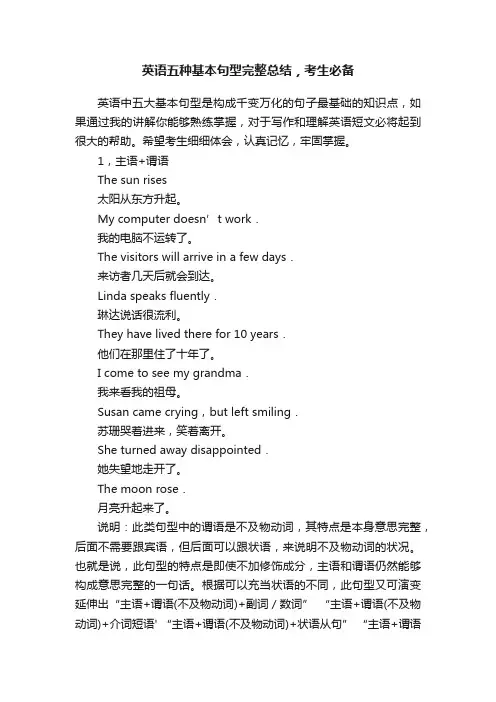
英语五种基本句型完整总结,考生必备英语中五大基本句型是构成千变万化的句子最基础的知识点,如果通过我的讲解你能够熟练掌握,对于写作和理解英语短文必将起到很大的帮助。
希望考生细细体会,认真记忆,牢固掌握。
1,主语+谓语The sun rises太阳从东方升起。
My computer doesn’t work.我的电脑不运转了。
The visitors will arrive in a few days.来访者几天后就会到达。
Linda speaks fluently.琳达说话很流利。
They have lived there for 10 years.他们在那里住了十年了。
I come to see my grandma.我来看我的祖母。
Susan came crying,but left smiling.苏珊哭着进来,笑着离开。
She turned away disappointed.她失望地走开了。
The moon rose.月亮升起来了。
说明:此类句型中的谓语是不及物动词,其特点是本身意思完整,后面不需要跟宾语,但后面可以跟状语,来说明不及物动词的状况。
也就是说,此句型的特点是即使不加修饰成分,主语和谓语仍然能够构成意思完整的一句话。
根据可以充当状语的不同,此句型又可演变延伸出“主语+谓语(不及物动词)+副词/数词” “主语+谓语(不及物动词)+介词短语' “主语+谓语(不及物动词)+状语从句” “主语+谓语(不及物动词)+动词不定式或分词。
2,主语+系动词+表语They are my classmates.他们是我的同学。
The notebook is hers.这个笔记本是她的。
The fish is still alive.鱼儿还活着。
We must be off now.我们必须走了。
The lawyer appeared calm.这个律师看起来很镇静。
Leaves have turned yellow.树叶变黄了。

英语五种基本句型及例句.doc 英语中有五种基本句型,它们是:S+V、S+V+O、S+V+I、S+V+O+O、S+V+C。
下面是每种基本句型的例句:1.S+V (主语+动词) 例句:•I study English.(我学习英语。
)•He runs every morning.(他每天早上跑步。
)•They play football on weekends.(他们周末踢足球。
)2.S+V+O (主语+动词+宾语) 例句:•She reads a book.(她读一本书。
)•We eat lunch at noon.(我们中午吃午饭。
)•They watch a movie on Friday night.(他们星期五晚上看电影。
)3.S+V+I (主语+动词+表语) 例句:•He is a doctor.(他是个医生。
)•She became famous.(她变得出名。
)•They feel happy.(他们感到快乐。
)4.S+V+O+O (主语+动词+宾语+宾语补足语) 例句:•She made me a cake.(她给我做了一个蛋糕。
)•They elected him class monitor.(他们选他当班长。
)•We consider the party a success.(我们认为这次派对很成功。
)5.S+V+C (主语+动词+补语) 例句:•He is a student.(他是个学生。
)•They are happy.(他们很快乐。
)•She feels tired.(她感到疲倦。
)这些例句展示了五种基本句型的运用。
它们可以通过改变主语、动词、宾语等部分来构造更多的句子。
熟练掌握这些基本句型,对于学习英语语法和提高英语写作能力非常重要。

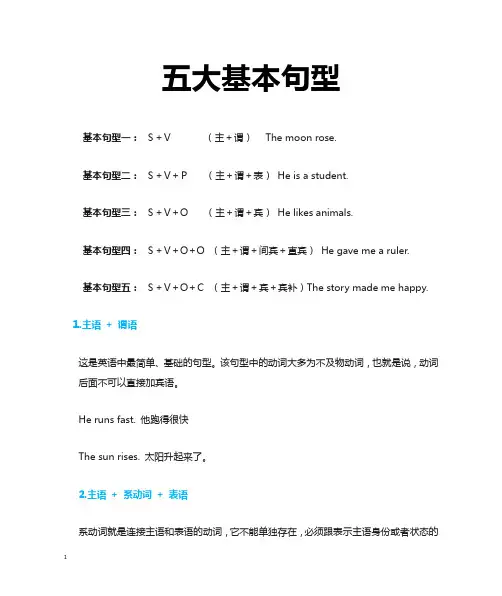
五大基本句型基本句型一:S+V(主+谓)The moon rose.基本句型二:S+V+P(主+谓+表)He is a student.基本句型三:S+V+O(主+谓+宾)He likes animals.基本句型四:S+V+O+O(主+谓+间宾+直宾)He gave me a ruler.基本句型五:S+V+O+C(主+谓+宾+宾补)The story made me happy.1.主语+ 谓语这是英语中最简单、基础的句型。
该句型中的动词大多为不及物动词,也就是说,动词后面不可以直接加宾语。
He runs fast. 他跑得很快The sun rises. 太阳升起来了。
2.主语+ 系动词+ 表语系动词就是连接主语和表语的动词,它不能单独存在,必须跟表示主语身份或者状态的1表语构成复合谓语,进而将意思表达完整。
(系动词不表示具体的行为,只是起到连接主语和后面成分的作用)系动词的分类系动词6大类是:状态系动词,感官系动词,表像系动词,终止系动词,持续系动词,变化系动词。
状态系动词:用来表示主语状态的只有be这个词。
He is a teacher.感官系动词:主要有feel、smell、sound和taste。
This flower smells very sweet.表像系动词:表示“外观”的概念主要有seem、appear和look。
终止系动词:表示主语结束了动作,主要有prove,turn out,表示“证实”、“成为”的意思。
The rumor proved false. 这谣言证实有假。
持续系动词:用来表示主语继续或维持情况或态度,主要有keep、remain、stay、lie和stand。
He always keeps silent at meeting.变化系动词:这些动词表示主语是怎样的,变化类动词主要有become、grow、turn、fall、get、go、come、run. His face turned red.3.主语+ 谓语+ 宾语这种句型中谓语动词常常是及物动词,也就是说,动词后可以直接加宾语。

英语的句型句式大全一、基础句型1.Subject + Verb–Examples:•She runs.•They eat.2.Subject + Verb + Object–Examples:•I love you.•He reads books.3.Subject + Verb + Indirect Object + Direct Object–Examples:•She gave me a gift.•He bought her a car.4.Subject + Verb + Complement–Examples:•She is happy.•They are friends.二、特殊句型1.Question Form–Examples:•Where is the cat?•Did you see the movie?2.Conditional Sentences–Examples:•If it rains, we will stay inside.•She would come if she had time.3.Passive Voice–Examples:•The book was written by the author.•The cake was eaten by the children.三、复杂句式1.Relative Clauses–Examples:•The boy who is wearing a red shirt is my brother.•The book that I borrowed from the library is interesting.2.Coordinating Conjunctions–Examples:•I want both the cake and the ice cream.•He is not only smart but also kind.3.Subordinating Conjunctions–Examples:•Although it was raining, we went out.•She will come when she finishes work.四、强调句型1.It is/was + Adjective + that/who + Subject + Verb–Example:•It was Mary who won the competition.2.Subject + Verb + what/who/which + Object + Verb–Example:•I saw what you did.五、形容词和副词的句型1.Adjective + Noun–Examples:•Beautiful flowers•Fast car2.Adverb + Verb–Examples:•Quickly run•Carefully readparative and Superlative Forms–Examples:•He is taller than his brother.•She is the smartest in the class.六、感叹句型1.What + Noun + Subject + Verb!–Example:•What a beautiful day it is!2.How + Adjective/Adverb + Subject + Verb!–Example:•How quickly he runs!以上是英语中常见的句型句式,掌握这些基础句型和特殊句型可以帮助提升英语表达能力,丰富句子结构,让语言更加生动自然。
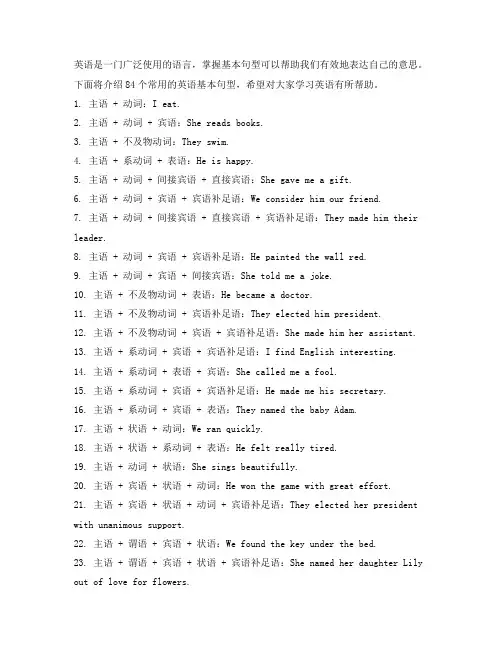
英语是一门广泛使用的语言,掌握基本句型可以帮助我们有效地表达自己的意思。
下面将介绍84个常用的英语基本句型,希望对大家学习英语有所帮助。
1. 主语 + 动词:I eat.2. 主语 + 动词 + 宾语:She reads books.3. 主语 + 不及物动词:They swim.4. 主语 + 系动词 + 表语:He is happy.5. 主语 + 动词 + 间接宾语 + 直接宾语:She gave me a gift.6. 主语 + 动词 + 宾语 + 宾语补足语:We consider him our friend.7. 主语 + 动词 + 间接宾语 + 直接宾语 + 宾语补足语:They made him their leader.8. 主语 + 动词 + 宾语 + 宾语补足语:He painted the wall red.9. 主语 + 动词 + 宾语 + 间接宾语:She told me a joke.10. 主语 + 不及物动词 + 表语:He became a doctor.11. 主语 + 不及物动词 + 宾语补足语:They elected him president.12. 主语 + 不及物动词 + 宾语 + 宾语补足语:She made him her assistant.13. 主语 + 系动词 + 宾语 + 宾语补足语:I find English interesting.14. 主语 + 系动词 + 表语 + 宾语:She called me a fool.15. 主语 + 系动词 + 宾语 + 宾语补足语:He made me his secretary.16. 主语 + 系动词 + 宾语 + 表语:They named the baby Adam.17. 主语 + 状语 + 动词:We ran quickly.18. 主语 + 状语 + 系动词 + 表语:He felt really tired.19. 主语 + 动词 + 状语:She sings beautifully.20. 主语 + 宾语 + 状语 + 动词:He won the game with great effort.21. 主语 + 宾语 + 状语 + 动词 + 宾语补足语:They elected her president with unanimous support.22. 主语 + 谓语 + 宾语 + 状语:We found the key under the bed.23. 主语 + 谓语 + 宾语 + 状语 + 宾语补足语:She named her daughter Lily out of love for flowers.24. 主语 + 谓语 + 不定式:They want to play.25. 主语 + 谓语 + 动词 + 不定式:He can swim.26. 主语 + 谓语 + 宾语 + 动词 + 不定式:She asked me to help.27. 主语 + 谓语 + 不定式 + 宾语补足语:We believe him to be honest.28. 主语 + 谓语 + 宾语 + 不定式 + 宾语补足语:He wants me to be his assistant.29. 主语 + 谓语 + 不定式 + 状语:You need to study hard.30. 主语 + 谓语 + 动名词:She enjoys swimming.31. 主语 + 谓语 + 宾语 + 动名词:They appreciate her singing.32. 主语 + 谓语 + 动名词 + 宾语补足语:I consider cooking an art.33. 主语 + 谓语 + 不定式 + 动名词:He started to learn painting.34. 主语 + 谓语 + 宾语 + 不定式 + 动名词:She saw him come in.35. 主语 + 谓语 + 宾语 + 不定式 + 状语:We made them stay longer.36. 主语 + 谓语 + 不定式 + 宾语补足语 + 动名词:He wants us to help him finish the project.37. 主语 + 谓语 + 不定式 + 宾语补足语 + 状语:I expect you to arrive on time.38. 主语 + 谓语 + 不定式 + 动名词 + 状语:They will try to solve the problem by working together.39. 主语 + 谓语 + 宾语 + 不定式 + 宾语补足语 + 状语:She persuaded him to stay after school for extra practice.40. 主语 + 谓语 + 分词:He looked tired.41. 主语 + 谓语 + 宾语 + 分词:They found the book interesting.42. 主语 + 谓语 + 分词 + 宾语补足语:We consider him qualified for the job.43. 主语 + 谓语 + 不定式 + 分词:She decided to leave quickly.44. 主语 + 谓语 + 宾语 + 不定式 + 分词:He heard her sing beautifully.45. 主语 + 谓语 + 分词 + 状语:They sat there, waiting for the bus.46. 主语 + 谓语 + 宾语 + 分词 + 状语:We saw her boarding the train.47. 主语 + 谓语 + 分词 + 宾语补足语 + 状语:He walked away, satisfied with his achievement.48. 主语 + 谓语 + 分词 + 不定式:She came running to me to ask a question.49. 主语 + 谓语 + 宾语 + 分词 + 不定式:They saw him standing alone in the rain.50. 主语 + 谓语 + 分词 + 宾语 + 不定式:We watched the movie, hoping to be entertained.51. 主语 + 谓语 + 不定式 + 分词 + 宾语补足语:He wants us to stay focused on our goals.52. 主语 + 谓语 + 不定式 + 分词 + 状语:She needs to finish her homework before going out.53. 主语 + 谓语 + 宾语 + 不定式 + 分词 + 状语:They made him work extra hours to meet the deadline.54. 主语 + 谓语 + 不定式 + 分词 + 宾语补足语:We believe you to have the ability to succeed.55. 主语 + 谓语 + 不定式 + 分词 + 宾语补足语 + 状语:He considered it a great honor to be chosen as the team captain.56. 主语 + 谓语 + 分词 + 状语 + 宾语:They finished the task, exhausted.57. 主语 + 谓语 + 宾语 + 分词 + 状语 + 宾语补足语:She found him standing there, helpless.58. 主语 + 谓语 + 分词 + 宾语 + 状语:He left the room, closing the door behind him.59. 主语 + 谓语 + 分词 + 宾语 + 宾语补足语:We saw her painting the wall red.60. 主语 + 谓语 + 宾语 + 分词 + 宾语补足语 + 状语:They heard him singing in the shower, beautifully.61. 主语 + 谓语 + 分词 + 不定式 + 状语:She stood there, not knowing what to say.62. 主语 + 谓语 + 宾语 + 分词 + 不定式 + 状语:He caught her reading his diary, secretly.63. 主语 + 谓语 + 分词 + 宾语 + 不定式 + 状语:They watched the kids playing happily in the park.64. 主语 + 谓语 + 不定式 + 分词 + 状语 + 宾语补足语:We want you to come prepared for the meeting.65. 主语 + 谓语 + 不定式 + 分词 + 宾语 + 状语:She asked me to stay quiet, not attracting attention.66. 主语 + 谓语 + 分词 + 状语 + 宾语 + 宾语补足语:They arrived at the party late, all dressed up.67. 主语 + 谓语 + 分词 + 宾语 + 状语 + 宾语补足语:I left the office, feeling satisfied with my performance.68. 主语 + 谓语 + 分词 + 宾语 + 宾语补足语 + 状语:He walked away, looking disappointed.69. 主语 + 谓语 + 不定式 + 宾语 + 分词:She wants us to keep the door closed, protecting the animals inside.70. 主语 + 谓语 + 不定式 + 状语 + 分词:They need to finish the project, no matter how hard it is.71. 主语 + 谓语 + 不定式 + 宾语 + 分词 + 状语:We would like you to come over for dinner, if you are available.72. 主语 + 谓语 + 不定式 + 分词 + 状语 + 宾语补足语:He decided to work harder, hoping to achieve better results.73. 主语 + 谓语 + 不定式 + 分词 + 宾语补足语 + 状语:She wanted him to leave, regardless of his apology.74. 主语 + 谓语 + 分词 + 宾语 + 不定式:They saw him running down the street to catch the bus.75. 主语 + 谓语 + 分词 + 不定式 + 宾语:He felt someone touch his shoulder, turning around to see who it was.76. 主语 + 谓语 + 分词 + 宾语 + 不定式 + 宾语补足语:She caught her sister eating her chocolate cake, scolding her for the theft.77. 主语 + 谓语 + 不定式 + 分词 + 宾语 + 状语:They asked me to speak louder, not being able to hear me clearly.78. 主语 + 谓语 + 不定式 + 分词 + 状语 + 宾语补足语:We advised him to approach the problem from a different angle, with the hope of finding a solution.79. 主语 + 谓语 + 不定式 + 宾语 + 分词 + 宾语补足语 + 状语:She reminded him to take his medicine, not forgetting his doctor's advice.80. 主语 + 谓语 + 不定式 + 分词 + 宾语 + 状语 + 宾语补足语:He urged them to apply for the position, fully aware of their qualifications. 81. 主语 + 谓语 + 分词 + 不定式 + 状语 + 宾语 + 宾语补足语:They watched the news report excitedly, hoping to see their favorite celebrity mentioned.82. 主语 + 谓语 + 分词 + 不定式 + 宾语 + 宾语补足语 + 状语:She left the room angrily, slamming the door shut.83. 主语 + 谓语 + 不定式 + 分词 + 状语 + 宾语 + 宾语补足语:We told him to study hard, not wasting his potential.84. 主语 + 谓语 + 不定式 + 分词 + 宾语 + 状语 + 宾语补足语:He encouraged her to believe in herself, never doubting her abilities.这些基本句型涵盖了常见的英语句子结构,掌握它们可以帮助你更好地表达自己的思想和意图。
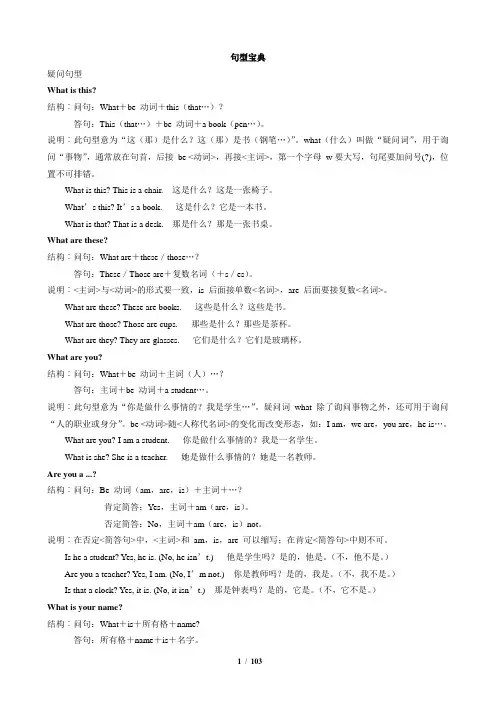
句型宝典疑问句型What is this?结构︰问句:What+be 动词+this(that…)?答句:This(that…)+be 动词+a book(pen…)。
说明︰此句型意为“这(那)是什么?这(那)是书(钢笔…)”。
what(什么)叫做“疑问词”,用于询问“事物”,通常放在句首,后接be <动词>,再接<主词>,第一个字母w要大写,句尾要加问号(?),位置不可排错。
What is this? This is a chair. 这是什么?这是一张椅子。
What’s this? It’s a book. 这是什么?它是一本书。
What is that? That is a desk. 那是什么?那是一张书桌。
What are these?结构︰问句:What are+these/those…?答句:These/Those are+复数名词(+s/es)。
说明︰<主词>与<动词>的形式要一致,is 后面接单数<名词>,are 后面要接复数<名词>。
What are these? These are books. 这些是什么?这些是书。
What are those? Those are cups. 那些是什么?那些是茶杯。
What are they? They are glasses. 它们是什么?它们是玻璃杯。
What are you?结构︰问句:What+be 动词+主词(人)…?答句:主词+be 动词+a student…。
说明︰此句型意为“你是做什么事情的?我是学生…”。
疑问词what 除了询问事物之外,还可用于询问“人的职业或身分”。
be <动词>随<人称代名词>的变化而改变形态,如:I am,we are,you are,he is…。
What are you? I am a student. 你是做什么事情的?我是一名学生。
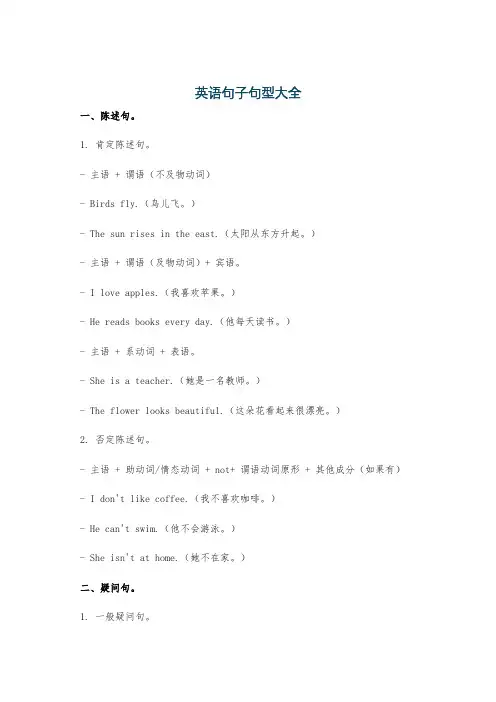
英语句子句型大全一、陈述句。
1. 肯定陈述句。
- 主语 + 谓语(不及物动词)- Birds fly.(鸟儿飞。
)- The sun rises in the east.(太阳从东方升起。
)- 主语 + 谓语(及物动词)+ 宾语。
- I love apples.(我喜欢苹果。
)- He reads books every day.(他每天读书。
)- 主语 + 系动词 + 表语。
- She is a teacher.(她是一名教师。
)- The flower looks beautiful.(这朵花看起来很漂亮。
)2. 否定陈述句。
- 主语 + 助动词/情态动词 + not+ 谓语动词原形 + 其他成分(如果有)- I don't like coffee.(我不喜欢咖啡。
)- He can't swim.(他不会游泳。
)- She isn't at home.(她不在家。
)二、疑问句。
1. 一般疑问句。
- 助动词/情态动词 + 主语 + 谓语动词原形 + 其他成分(如果有)- Do you like music?(你喜欢音乐吗?)- Can he speak English?(他会说英语吗?)- Is she your sister?(她是你的姐姐吗?)2. 特殊疑问句。
- 特殊疑问词 + 一般疑问句语序。
- What do you do?(你是做什么的?)- Where is he from?(他来自哪里?)- How old are you?(你多大了?)3. 选择疑问句。
- 一般疑问句 + or+ 选择部分。
- Do you like tea or coffee?(你喜欢茶还是咖啡?)- Is he a student or a teacher?(他是学生还是教师?)4. 反意疑问句。
- 陈述句 + 简短的附加疑问句(助动词/情态动词 + 主语(代词))- You are a student, aren't you?(你是一名学生,不是吗?)- He can't drive, can he?(他不会开车,是吗?)三、祈使句。
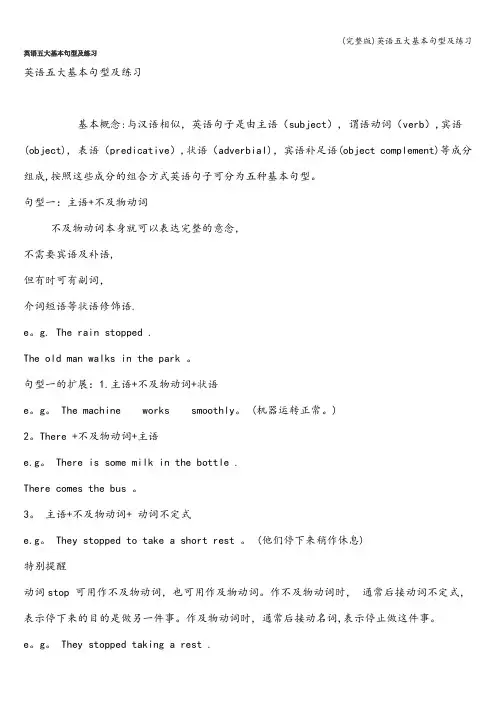
英语五大基本句型及练习英语五大基本句型及练习基本概念:与汉语相似,英语句子是由主语(subject), 谓语动词(verb),宾语(object), 表语(predicative),状语(adverbial),宾语补足语(object complement)等成分组成,按照这些成分的组合方式英语句子可分为五种基本句型。
句型一:主语+不及物动词不及物动词本身就可以表达完整的意念,不需要宾语及补语,但有时可有副词,介词短语等状语修饰语.e。
g. The rain stopped .The old man walks in the park 。
句型一的扩展:1.主语+不及物动词+状语e。
g。
The machine works smoothly。
(机器运转正常。
)2。
There +不及物动词+主语e.g。
There is some milk in the bottle .There comes the bus 。
3。
主语+不及物动词+ 动词不定式e.g。
They stopped to take a short rest 。
(他们停下来稍作休息)特别提醒动词stop 可用作不及物动词,也可用作及物动词。
作不及物动词时,通常后接动词不定式,表示停下来的目的是做另一件事。
作及物动词时,通常后接动名词,表示停止做这件事。
e。
g。
They stopped taking a rest .句型二:主语+系动词+表语系动词本身不能表达完整的意念没,需要形容词,名词,介词短语等来补充说明主语,也叫主语补语.e.g. My sister is a nurse .I feel quite hungry .The ball is under the desk .句型三:主语+及物动词+宾语及物动词本身需要一个动作的接受者(宾语),才可以表达一个完整的意念.e.g。
We are learning English 。
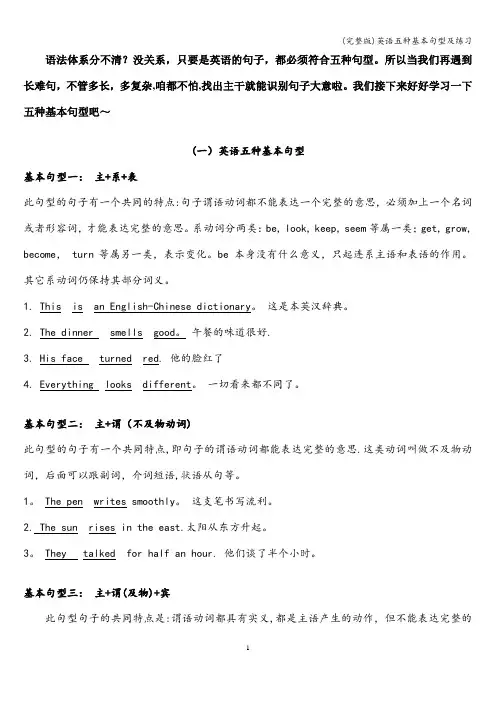
语法体系分不清?没关系,只要是英语的句子,都必须符合五种句型。
所以当我们再遇到长难句,不管多长,多复杂,咱都不怕,找出主干就能识别句子大意啦。
我们接下来好好学习一下五种基本句型吧~(一)英语五种基本句型基本句型一:主+系+表此句型的句子有一个共同的特点:句子谓语动词都不能表达一个完整的意思,必须加上一个名词或者形容词,才能表达完整的意思。
系动词分两类:be, look, keep, seem等属一类;get, grow, become, turn等属另一类,表示变化。
be 本身没有什么意义,只起连系主语和表语的作用。
其它系动词仍保持其部分词义。
1. This is an English-Chinese dictionary。
这是本英汉辞典。
2. The dinner smells good。
午餐的味道很好.3. His face turned red. 他的脸红了4. Everything looks different。
一切看来都不同了。
基本句型二:主+谓(不及物动词)此句型的句子有一个共同特点,即句子的谓语动词都能表达完整的意思.这类动词叫做不及物动词,后面可以跟副词,介词短语,状语从句等。
1。
The pen writes smoothly。
这支笔书写流利。
2. The sun rises in the east.太阳从东方升起。
3。
They talked for half an hour. 他们谈了半个小时。
基本句型三:主+谓(及物)+宾此句型句子的共同特点是:谓语动词都具有实义,都是主语产生的动作,但不能表达完整的意思,必须跟有一个宾语,即动作的承受者,才能使意思完整。
这类动词叫做及物动词。
1。
Who knows the answer?谁知道答案?2. He enjoys reading。
他喜欢看书.3。
My sister is writing a letter at this moment。
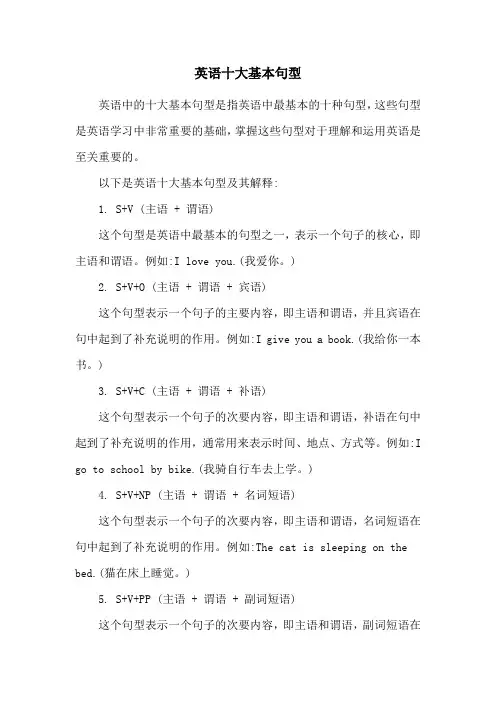
英语十大基本句型英语中的十大基本句型是指英语中最基本的十种句型,这些句型是英语学习中非常重要的基础,掌握这些句型对于理解和运用英语是至关重要的。
以下是英语十大基本句型及其解释:1. S+V (主语 + 谓语)这个句型是英语中最基本的句型之一,表示一个句子的核心,即主语和谓语。
例如:I love you.(我爱你。
)2. S+V+O (主语 + 谓语 + 宾语)这个句型表示一个句子的主要内容,即主语和谓语,并且宾语在句中起到了补充说明的作用。
例如:I give you a book.(我给你一本书。
)3. S+V+C (主语 + 谓语 + 补语)这个句型表示一个句子的次要内容,即主语和谓语,补语在句中起到了补充说明的作用,通常用来表示时间、地点、方式等。
例如:I go to school by bike.(我骑自行车去上学。
)4. S+V+NP (主语 + 谓语 + 名词短语)这个句型表示一个句子的次要内容,即主语和谓语,名词短语在句中起到了补充说明的作用。
例如:The cat is sleeping on the bed.(猫在床上睡觉。
)5. S+V+PP (主语 + 谓语 + 副词短语)这个句型表示一个句子的次要内容,即主语和谓语,副词短语在句中起到了补充说明的作用。
例如:The sun is shining brightly.(太阳正在明媚地照耀。
)6. S+V+OC (主语 + 谓语 + 宾语 + 补语)这个句型表示一个句子的主要内容,即主语和谓语,宾语和补语在句中起到了补充说明的作用。
例如:I see a cat jumping over the fence.(我看见一只猫跃过篱笆。
)7. S+V+CC (主语 + 谓语 + 补语 + 宾语)这个句型表示一个句子的主要内容,即主语和谓语,宾语在句中起到了补充说明的作用,而补语则起到了强调的作用。
例如:I love you, that"s all.(我爱你,就这些。
英语六种基本句型一、六种基本句型1. 主语+不及物动词例: I do.2. 主语+不及物动词+状语例:He left last night.3. 主语+动词(及物动词)+宾语例:I have a son.4. 主语+谓语(及物动词)+双宾语(间接宾语+直接宾语)例:I can give you an apple.指人的是间接宾语和指物的是直接宾语5. 主语+谓语(系动词)+表语该句型谓语动词为连系动词.常见的系动词有:be(是); get(变得), become(成为), turn(变得), look(看起来), feel(感到), smell(闻起来), taste(尝起来), sound(听起来), seem(似乎) 等.例:The apple tastes good.6. 主语+谓语+宾语+宾语补足语6.1. 接形容词作宾语补足语例1:You make me happy.例2:You keep me waiting.6.2. 接动词不定式作宾语补足语例:Our teacher told Tom to come here tomorrow.6.3. 宾语补足语为动词原形或doing形式四看:watch、see、look、notice、observe二听:listen to (听)、hear(听见)一感觉:feel(感觉)宾语补足语用动词原形 (省略to)表示全过程,用doing形式表示该动作当时正在发生。
例1: We see her dance in the next door.我们看到她在隔壁跳舞。
(全过程)例2: We see her dancing in the next door. 我们看到她正在在隔壁跳舞.。
句型宝典疑问句型What is this?结构:问句:What + be动词+ this (that…)?答句:This (that…)+ be 动词+ a book (pen…)。
说明:此句型意为“这(那)是什么?这(那)是书(钢笔…)”。
what (什么)叫做“疑问词”,用于询be <动词>,再接<主词>,第一个字母w 要大写,句尾要加问号(?),位问“事物”,通常放在句首,后接置不可排错。
What is this? This is a chair. 这是什么?这是一张椅子。
What' s this? It's a book. 这是什么?它是一本书。
What is that? That is a desk. 那是什么?那是一张书桌。
What are these?结构:问句:What are+ these/ those …?答句:These/Those are+复数名词(+ s/ es)。
说明:<主词>与<动词>的形式要一致,is 后面接单数<名词>,are 后面要接复数<名词>。
What are these? These are books. 这些是什么?这些是书。
What are those? Those are cups. 那些是什么?那些是茶杯。
What are they? They are glasses. 它们是什么?它们是玻璃杯。
What are you?结构:问句:What + be动词+主词(人)…?答句:主词+ be动词+ a stude nt…。
说明:此句型意为“你是做什么事情的?我是学生…”。
疑问词what除了询问事物之外,还可用于询问“人的职业或身分” 。
be <动词>随<人称代名词>的变化而改变形态,如:I am, we are, you are, he is…。
What are you? I am a student. 你是做什么事情的?我是一名学生。
英语八大基本句型解释及例句1.主语+ 谓语(不及物动词)1.句型解释:这种句型中,谓语动词是不及物动词,能够完整地表达主语的动作,不需要宾语。
句子结构比较简单,重点在于描述主语的行为或状态的变化。
2.例句:1.The sun rises.(太阳升起。
)“the sun” 是主语,表示动作的执行者,“rises” 是不及物动词,描述太阳的动作。
2.Birds fly.(鸟飞。
)“birds” 是主语,“fly” 是不及物动词,表明鸟的行为。
3.She smiles.(她微笑。
)“she” 是主语,“smiles”这个不及物动词体现了她的表情动作。
2.主语+ 谓语(及物动词)+ 宾语1.句型解释:在这个句型里,谓语动词是及物动词,需要有宾语来接受动作,才能使句子意思完整。
宾语通常是名词、代词或者相当于名词的短语等,用来回答谓语动词“动作的对象是什么” 的问题。
2.例句:1.He reads books.(他读书。
)“he” 是主语,“reads” 是及物动词,“books” 是宾语,表明“读” 这个动作的对象是书。
2.She loves music.(她喜欢音乐。
)“she” 为主体即主语,“loves” 是表达情感的及物动词,“music” 作为宾语,是“爱” 这个动作所涉及的内容。
3.They play football.(他们踢足球。
)“they” 是主语,“play” 是及物动词,“football” 是宾语,清楚地展示了动作及其对象。
3.主语+ 系动词+ 表语1.句型解释:此句型主要用于描述主语的特征、状态、身份等。
系动词起到连接主语和表语的作用,本身有一定的含义,但不能单独作谓语,表语通常是名词、形容词、副词、介词短语、不定式或从句等,用于说明主语的情况。
2.例句:1.She is a teacher.(她是一名教师。
)“she” 是主语,“is” 是系动词,“a teacher” 是表语,表明她的身份。
小学英语知识点——五种简单句基本句型·例句句式1:主语+ 谓语(即“主谓”句型)[例句] They arrived. 他们到了。
[分析]主语+谓语=they+arrived句式2:主语+谓语+宾语(即“主谓宾”句型)[例句]I played football last Friday. 上周五我踢球来着。
[分析]主语+谓语+宾语=I+played+football句式3:主语+谓语+间接宾语+直接宾语(即“主谓双宾”句型)[例句] The teacher taught us English. 这位老师教过我们英语。
[分析]主语+谓语+间接宾语+直接宾语=the teacher+taught+us+English句式4:主语+谓语+宾语+宾语补足语(即“主谓宾宾补”句型)[例句]He asked her to go there. 他让她去那里。
[分析]主语+谓语+宾语+宾语补足语=he+asked+her+to go there句式5:主语+系动词+表语(即“主系表”句型)[例句]I am a teacher. 我是一位老师。
[分析]主语+系动词+表语=I+am(be)+a teacher(表明主语身份)小学英语知识点——五种简单句基本句型·例句句式1:主语+ 谓语(即“主谓”句型)[例句] They arrived. 他们到了。
[分析]主语+谓语=they+arrived句式2:主语+谓语+宾语(即“主谓宾”句型)[例句]I played football last Friday.上周五我踢球来着。
[分析]主语+谓语+宾语=I+played+football句式3:主语+谓语+间接宾语+直接宾语(即“主谓双宾”句型)[例句] The teacher taught us English. 这位老师教过我们英语。
[分析]主语+谓语+间接宾语+直接宾语=the teacher+taught+us+English句式4:主语+谓语+宾语+宾语补足语(即“主谓宾宾补”句型)[例句]He asked her to go there.他让她去那里。
英语五个基本句式及句子成分(basic sentence patterns and different components )前言:这份资料是老师非常认真整理出来的,请大家,特别是基础比较差的同学一定要从头至尾认认真真看几遍,慢慢消化当中的知识点,对你们学好英语一定会有很大的帮助的!!So why not have a try?一、Different components: (各种成分)英语的句子成分跟中文的句子成分很像的,主要包括下面这些:1. 主语 subject (简写S)2.谓语 predicate 分为:intransitive verb (vi)/ transitive verb (vt)3. 宾语 object (分为:direct object / indirect object ) (简写O)4. 宾补 object complement (简写OC)5. 状语adverbial6. 表语predicative7. 定语attributive## :No matter how long the sentence is, it consists of some of these components.不管多长的句子,都是由这些成分当中的一些所构成的。
1、主语:可以作主语的成分有名词(如boy),主格代词(如you),数词(numeral),动词不定式,动名词,从句等。
主语一般在句首。
注意名词单数形式常和冠词不分家!eg: The boy comes from America. (名词作主语)He made a speech. (代词作主语)Two and two is four. (数词作主语)To be a teacher is my dream. (不定式作主语)Doing a research is a necessary step of covering a story. (动名词作主语)That he is admitted to a key university is known to us all. (从句作主语,也就是我们说的主语从句)中文里“某人做某事”做主语时,常用以下句式:to do sth To be a teacher is my dream.doing sth Teaching is his job.That/when从句 That he hopes to be a teacher is known to us all.Sb’s doing sth His being a teacher makes him proud.It …… for sb to do sth It is important for us to study English well.It is no use / good doing sth It is no use crying.It …… 从句。
英语五种基本句型基本句型一:主+谓(不及物:不加宾语的动词)1. The sun │was shining. 太阳在照耀着2. The moon │rose. 月亮升起了.3. They work hard4. Many animals live in trees。
5. The children are playing happily基本句型二:主+系+表1. This │is │an English-Chinese dictionary. 这是本英汉辞典.2. The dinne r │smells │good. 午餐的气味很好.3. The flower is dead.4. He became a famous doctor.5. The apple pie tastes really delicious。
基本句型三:主+谓(及物:可加宾语的动词)+宾1. Who │knows │the answer?谁知道答案?2. He │admits │that he was mistaken. 他承认犯了错误3. Plants need water.4. The Greens enjoy living in China.基本句型四:主+谓(及物)+双宾(间宾+直宾)1. She │ordered │herself │a new dress. =She ordered a new dress for herself.她给自己定了一套新衣裳.2. I │showed │him │my pictures. 我给他看我的照片.3. He gives me some seeds4. My aunt bought me a computer. = My aunt bought a computer for me.5. I passed him the salt. = I passed the salt to him。
句型宝典疑問句型What is this?結構︰問句:What+be 動詞+this(that…)?答句:This(that…)+be 動詞+a book(pen…)。
說明︰此句型意為“這(那)是什麼?這(那)是書(鋼筆…)”。
what(什麼)叫做“疑問詞”,用於詢問“事物”,通常放在句首,後接 be <動詞>,再接<主詞>,第一個字母w要大寫,句尾要加問號(?),位置不可排錯。
What is this? This is a chair. 這是什麼?這是一張椅子。
What’s this? It’s a book. 這是什麼?它是一本書。
What is that? That is a desk. 那是什麼?那是一張書桌。
What are these?結構︰問句:What are+these/those…?答句:These/Those are+複數名詞(+s/es)。
說明︰<主詞>與<動詞>的形式要一致,is 後面接單數<名詞>,are 後面要接複數<名詞>。
What are these? These are books. 這些是什麼?這些是書。
What are those? Those are cups. 那些是什麼?那些是茶杯。
What are they? They are glasses. 它們是什麼?它們是玻璃杯。
What are you?結構︰問句:What+be 動詞+主詞(人)…?答句:主詞+be 動詞+a student…。
說明︰此句型意為“你是做什麼事情的?我是學生…”。
疑問詞 what 除了詢問事物之外,還可用於詢問“人的職業或身分”。
be <動詞>隨<人稱代名詞>的變化而改變形態,如:I am,we are,you are,he is…。
What are you? I am a student. 你是做什麼事情的?我是一名學生。
What is she? She is a teacher. 她是做什麼事情的?她是一名教師。
Are you a ...?結構︰問句:Be 動詞(am,are,is)+主詞+…?肯定簡答:Yes,主詞+am(are,is)。
否定簡答:No,主詞+am(are,is)not。
說明︰在否定<簡答句>中,<主詞>和 am,is,are 可以縮寫;在肯定<簡答句>中則不可。
Is he a student? Yes, he is. (No, he isn’t.) 他是學生嗎?是的,他是。
(不,他不是。
)Are you a teacher? Yes, I am. (No, I’m not.) 你是教師嗎?是的,我是。
(不,我不是。
)Is that a clock? Yes, it is. (No, it isn’t.) 那是鐘錶嗎?是的,它是。
(不,它不是。
)What is your name?結構︰問句:What+is+所有格+name?答句:所有格+name+is+名字。
說明︰“my,your,his,her”為單數人稱的<所有格>;<所有格>後面必接<名詞>,即“<所有格>+<名詞>”;<所有格>不可與a,an,this,that,these 或 those 緊接一起使用。
What is your name? My name is Sue. 妳叫什麼名字?我的名字叫蘇。
What is his name? His name is John. 他叫什麼名字?他的名字叫約翰。
What is her name? Her name is Jean. 她叫什麼名字?她的名字叫珍。
Who is that ...?結構︰問句:Who+be 動詞+that+形容詞+名詞?答句:That is+名字。
說明︰Who 是<疑問代名詞>,詢問人的“姓名”或“關係”;將<形容詞>直接放在<名詞>前面,叫做“前位修飾”。
Who is that short boy? That is Bill. 那位矮男孩是誰?那位是比爾。
Who is that tall girl? That is Mary. 那位高女孩是誰?那位是瑪麗。
Who is that fat man? He is my uncle. 那位胖男子是誰?那位是我叔叔。
Where is ...?結構︰問句:Where+be 動詞(am,are,is)+主詞…?答句:主詞+be 動詞+in the+名詞…。
說明︰問句是“Where ...?”,簡答時可用<副詞片語>“In/On the+<名詞>”。
Where is Sue? She is in her room. 蘇在那裡?她在她的房間裡。
Where are your books? On the desk. 你的書在那裡?在書桌上。
Where is your mother? She is in the kitchen. 你媽嗎在哪裡?她在廚房裡。
Are you V-ing ...?結構︰Am(Are,Is)+主詞+現在分詞…?說明︰此句型意為“<主詞>(人,物)正在…嗎?”。
這一<句型>轉換的三要素是:be <動詞>移到句首;改為大寫;句尾用問號。
Is Mary sleeping? 瑪麗正在睡覺嗎?Are you reading a book? 你正在看書嗎?Is the dog playing? 小狗正在玩耍嗎?What are you doing?結構︰問句:What+am(are,is)+主詞+現在分詞?答句:主詞+am(are,is)+現在分詞…。
說明︰“<主詞>(人)正在做什麼?<主詞>(人)正在…”。
注意:<祈使句>的動詞只能用原形,不可造<現在進行式>;表示“瞬間產生”的動作的<動詞片語>,如 sit down,stand up,不可造<現在進行式>。
What am I doing? You are reading a book. 我正在做什麼?你正在閱讀一本書。
What are the girls doing? They are singing. 姑娘們正在做什麼?她們在唱歌。
What is Bill writing? He is writing a letter. 比爾在寫什麼?他在寫一封信。
How old are you?結構︰問句:How old+be 動詞+主詞(某人)?答句:主詞(某人)+be 動詞+year(s) old。
說明︰此句型意為“某人幾歲?某人是…歲”。
該句型中,<疑問詞>要用 how,不可用 what;且 be <動詞>(am,is,are)要和後面的<主詞>(某人)配合;答句中的“year(s) old”可以省略。
How old are you? I am twelve (years old). 你幾歲?我十二歲。
How old is your sister? She is thirteen years old. 你的姊妹幾歲?她十三歲。
How old is John? He is one year old. 約翰幾歲?他一歲。
What time is it?結構︰問句:What time is it?答句:It is+數字+o’clock。
說明︰此句型意為“現在是幾點鐘?現在是…點鐘”。
問句中 what 當<形容詞>,修飾後面的<名詞> time;time 當時間解時,只能用單數,不可用複數。
What time is it? It is ten o’clock. 現在是幾點鐘?現在是十點鐘。
What time is it? It is six o’clock. 現在是幾點鐘?現在是六點鐘。
What time is it? It is nine o’clock. 現在是幾點鐘?現在是九點鐘。
Do you + V ...?結構︰問句:Do/Does+主詞+原形動詞…?肯定簡答:Yes,主詞+do/does。
否定簡答:No,主詞+don’t/doesn’t。
說明︰肯定句中,如有一般<動詞>(speak,work,teach…),則在句首加<助動詞> do 或 does,並將一般<動詞>改為原形<動詞>(不加s或es),即構成<疑問句>。
Do you speak English? Yes, I do. (No, I don’t.)你講英語嗎?是的,我講英語。
(不,我不講英語。
)Does she have a cat? Yes, she does. (No, she doesn’t.)她有一隻貓嗎?是的,她有一隻貓。
(不,她沒有一隻貓。
)Do they work in office? Yes, they do. (No, they don’t.)他們在辦公室裡工作嗎?是的,他們在辦公室裡工作。
(不,他們不在辦公室裡工作。
)What time do you + V ...?結構︰問句:What time+do/does+主詞+原形動詞…?答句:主詞(某人)+一般動詞…+時間。
說明︰此句型意為“某人幾點做某事?”<助動詞> do 或 does 的選擇依<主詞>而定,若<主詞>為第三人稱單數,用 does;其它用 do。
What time do you get up? I usually get up at six. 你幾點起床?我通常六點起床。
What time does he go to bed? He usually goes to bed at ten.他幾點就寢?他通常十點就寢。
What time does your class begin? It begins at eight-ten.你的課幾點開始?八點十分開始。
What day is today?結構︰問句:What day is today?答句:It’s+Sunday/Monday/…。
說明︰此句型意為“今天是星期幾?今天是星期日/星期一/…。
”it 可用於指“星期的名稱”,但 this或 that 不可以;一星期七天的名稱,都是<專有名詞>,開頭的首字母要大寫,前面不加<冠詞>。
What day is today? It’s Sunday. 今天是星期幾?今天是星期日。